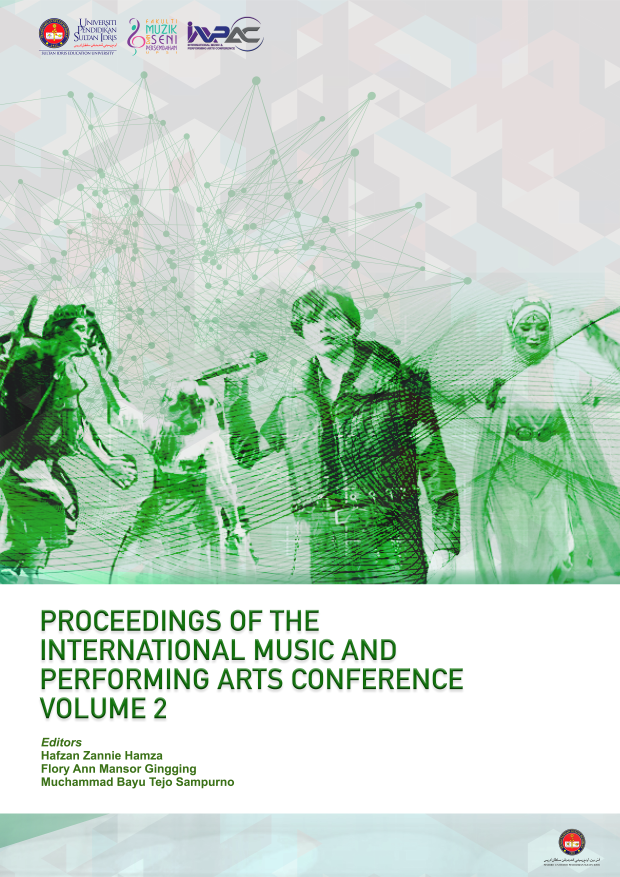Practical Guidelines for Choral Singing in the Elderly
DOI:
https://doi.org/10.37134/impac.v2.11.2024Keywords:
choral singing, practical guideline of choral singing, elderly, characteristics of choral singingAbstract
Choral singing involves the performance of two or more vocal parts. This article summarizes the synthetic results of practical guidance for choral singing among a senior group, including three vocal parts: soprano, alto, and tenor. This practical guidance derived from the synthesized analysis of the melodic characteristics of the song "Let’s Play with Me". This song was especially composed for the elderly. The composer categorized the characteristics of harmonic melody into four types: (1) identical lyrics and rhythms at different pitches; (2) identical lyrics at different times and pitches; (3) distinct lyrics and melodies occurring simultaneously; and (4) disparate melodies that engage with one another. Choral singing poses challenges for novice groups, particularly for senior individuals without prior experience in this discipline. Consequently, the conductor had to identify various approaches to enhance the vocal skills of senior singers. During the choral singing practice of elderly singers from January to July 2023, it was determined that practical guidelines may be categorized into five concerns grounded in music theory and practice, including (1) rehearsing melodies using the solfeggio technique, (2) learning rhythmic accuracy, (3) studying lyric pronunciation, (4) practicing singing in two- and three-part harmonies, and (5) training auditory capacity while singing. These guidelines function as an approach for seniors and beginners to improve essential choral singing skills, establishing a basis for advanced skills enhancement.
Downloads
References
Amatyakul, D. (2003). Choral singing. Bangkok: Active Print.
Bell, C. L. (2008). Toward a definition of a community choir. International Journal of Community Music, 1(2), 229–241. https://doi.org/10.1386/ijcm.1.2.229_1
Choir Trainer’s Guide. (2009). Voice for life: White level. Retrieved from https://www.academia.edu/4458391/White_Level_Choir_Trainer_s_Guide_Choir_Trainer_s_Guide
Coelho, A. C. de C., Daroz, I. F., Silvério, K. C. A., & Brasolotto, A. G. (2013). Amateur choir singers: Self-image, difficulties and symptoms of the singing voice. CEFAC, 15(2), 436–444. https://www.scielo.br/j/rcefac/a/Q36WyC6TPWZWcTdgDtWcWRp/?format=pdf&lang=en
Community Music Center. (2023). Older adult choir program. Retrieved from https://sfcmc.org/adults/older-adult-choir-program/
Hung, J. (2012). An investigation of the influence of fixed-do and movable-do solfège systems on sight-singing pitch accuracy for various levels of diatonic and chromatic complexity [Doctoral dissertation, The University of San Francisco].
Inkhong, N., Amatyakul, P., & Pidorajt, N. (2020). Neumatic singing in Thai popular singing, 1925–1967. Pertanika Journal of Social Sciences & Humanities, 28(1), 647–659.
Knaus, H., Peschl, W., Rehorska, W., & Winter, C. (2013). Musik Erziehung Spezial. AGMOE, 66(3). Retrieved from https://www.agmoe.at/wp-content/uploads/2014/05/AGMOE_MA_Spezial_2013_3.pdf
McMahon, M. (2023). What is a choir? Retrieved from https://www.musicalexpert.org/what-is-a-choir.htm
Miller, M. (2005). The complete idiot’s guide to music theory (2nd ed.). USA: Penguin Group.
Moura, W. E. R., Gadenz, C. D., Lemos, I. de O., Bós, Â. J. G., & Cassol, M. (2022). Analysis of the singing voice handicap index for elderly choristers. CoDAS, 34(1). https://doi.org/10.1590/2317-1782/20212020302
Niessen, A., Lehmann-Wermser, A., Knigge, J., & Lehmann, C. (2020). Entwurf eines Kompetenzmodells, Musik wahrnehmen und kontextualisieren. Retrieved from https://www.zfkm.org/sonder08-niessenetal.pdf
Pancharoen, N. (2010). Form and analysis (5th ed.). Bangkok: Tana Press.
Rustling.Org. (n.d.). Understanding different types of choirs. Retrieved from https://www.rustling.org/2014/12/understanding-different-types-of-choirs.html
Suhaimi, N. (2014). Vocal and choral techniques. Retrieved from https://www.scribd.com/doc/202747683/Vocal-and-Choral-Techniques#
The Rev. J. Troutbeck, D.D. (n.d.). Church choir training. London & New York: Novello, Ewer, and Co.
Wave, M. (2017). Reading choir music for beginners. Retrieved from https://merseywavemusic.com/wp-content/uploads/2017/05/Music-theory-for-choirs.pdf
Downloads
Published
Issue
Section
License
Copyright (c) 2024 Nutthan Inkhong (Author)

This work is licensed under a Creative Commons Attribution-NonCommercial-NoDerivatives 4.0 International License.
Authors retain copyright and grant the Proceedings of the International Music and Performing Arts Conference (IMPAC Proceedings) the right of first publication.
This licence permits unrestricted use, distribution, and reproduction in any medium, provided the original work is properly cited.




